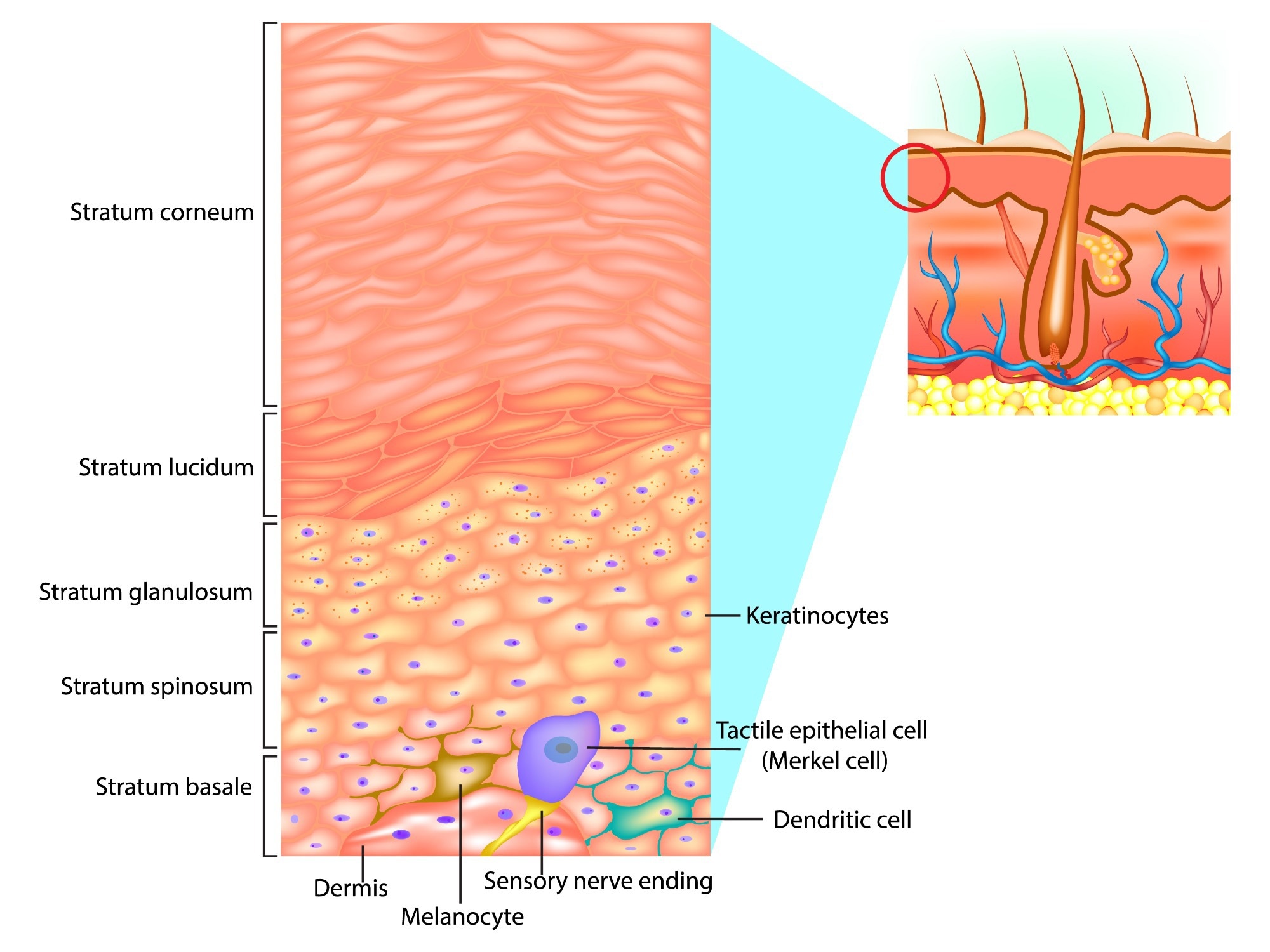The epidermis is the thin outer layer of the skin that is visible to the eye and works to protect the body. This part of the skin does not contain any blood vessels. It is, therefore, dependent on the dermis, which is the layer of the skin located directly underneath the epidermis, to provide access to nutrients and dispose of waste.

Thin skin showing the epidermis with its different strata, resting on the dermis. Image Credit: Jose Luis Calvo / Shutterstock.com
Cells in the epidermis
Keratinocytes
Keratinocytes are the most common type of cell in the epidermis and are responsible for synthesizing the protein keratin. These cells exist in progressive stages of differentiation from the deepest to the superficial layers of cells.
Moreover, keratinocytes originate from the basal layer, the deepest layer of the epidermis, and gradually move up to the outside layer of the epidermis. Here, keratinocytes are shed from the skin and replaced by new maturing cells.
Melanocytes
Melanocytes are another type of cell in the epidermis that are present throughout the basal layer. These cells are responsible for the production of melanin, which contributes to the skin color of the individual. Melanin also helps to protect the body from ultraviolet (UV) radiation present in sunlight, which can damage the DNA of the skin cells.
Langerhans cells
Langerhans cells produced in the bone marrow are also present in the epidermis and work to detect foreign substances and infections as part of the skin's immune system. These cells are also thought to be involved in the development of skin allergies.
Merkel cells
Merkel cells originate from neural crest cells and are responsible for the perception of gentle touch. These cells are present in the epidermis in specific areas of the skin, such as the nail beds and genitalia.
Structure
The epidermis consists of stratified squamous epithelial cells. There are four layers of the epidermis, according to the maturation of the cells:
- Stratum germinativum
- Stratum spinosum
- Stratum granulosum
- Stratum corneum

Cells of the epidermis and epidermal layers. The diagram depicts a cross-sectional view of the epidermis. Image Credit: Sakurra / Shutterstock.com
The stratum germinativum is the innermost layer, which adjoins the dermal layer of skin and is where the keratinocyte cells originate. Comparatively, the stratum corneum is the outermost layer, which is relatively waterproof and prevents the entry of bacteria, viruses, and other foreign substances into the body.
The thickness of the epidermis depends on the level of protection required for that area of the body. For example, the palms of the hands and the soles of the feet have a significantly thicker layer of keratin in the epidermis that can have a thickness of up to 2.3 millimeters (mm). This protects the body from the high impact to which these areas of the body are subject. In contrast, the thickness of the epidermis on the eyelids is approximately 0.05 mm thick.
Function
All layers of the skin, including the epidermis, are responsible for the protection of the body, including internal organs, muscles, nerves, and blood vessels. Additional roles of the epidermis include:
- Production of new skin cells
- Production of melanin to give color to the skin, as well as reduce the absorption and impact of UV radiation
- Physical protection of the body
- Immune protection of the body
Dependence on the dermis
As there is no direct blood supply to the epidermis, this outermost layer of the skin relies on the underlying dermis for the supply of nutrients and disposal of waste products. This occurs via a process of diffusion through the dermo-epidermal junction, which lies just below the stratum germinativum of the epidermis.
References
- Skin Anatomy: Overview, Epidermis, Dermis.” EMedicine, 9 Nov. 2019, http://emedicine.medscape.com/article/1294744-overview#a2
- Structure and Function of the Skin - Skin Disorders.” MSD Manual Consumer Version, http://www.msdmanuals.com/home/skin-disorders/biology-of-the-skin/structure-and-function-of-the-skin
- The Layers of Your Skin | American Academy of Dermatology.” Aad.org, 2019, https://www.aad.org/public/kids/skin/the-layers-of-your-skin
- Cartlidge, Patrick. “The Epidermal Barrier.” Seminars in Neonatology, vol. 5, no. 4, Nov. 2000, pp. 273–280, http://www.ncbi.nlm.nih.gov/pubmed/11032710
Further Reading